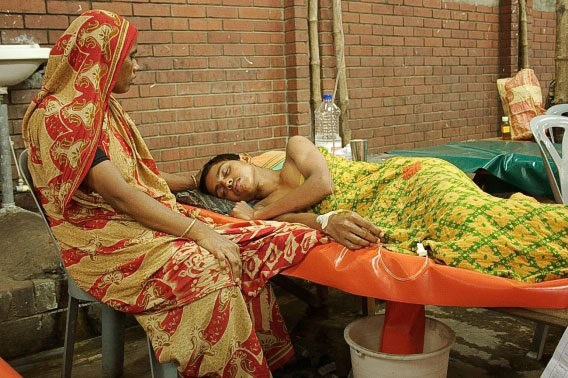Fighting Cholera—With Information
Medical student Eric Nelson leads an effort to send medical expertise around the world on a CD
By Jacqueline Mitchell
Right now as you read this, someone is suffering from cholera. In November, the fast-acting diarrheal disease swept through refugee camps in the Democratic Republic of Congo, where a quarter of a million people have been displaced by civil war. In Iraq, which did not see outbreaks for 50 years, authorities confirmed more than 300 cases across nine provinces this fall. In Zimbabwe, more than 16,000 people have been infected since August, and at least 780 have died.

Untreated, the sudden, acute diarrhea that cholera brings on can kill an otherwise-healthy adult in a day. But with treatment, such as given in Bangladesh, less than 1 percent of people who contract the disease die. Photo: Courtesy of Eric Nelson
“Cholera is one indicator of the collapse of a civilization,” says Eric J. Nelson, M10.
Nelson is on a mission to educate relief workers and public health officials about how to stop a cholera outbreak in its tracks. Together with Danielle Kauk, M07, a second-year resident in family medicine, and other colleagues, Nelson developed the Cholera Outbreak Training and Shigellosis (COTS) program, a CD that’s part textbook and part instruction manual about the prevention, diagnosis and treatment of diarrheal outbreaks.

Eric Nelson, M10. Photo: Stephen Sheffield
As a Ph.D. student in the lab of Andrew Camilli, a professor of molecular biology and microbiology, Nelson focused on cholera’s transmission and pathogenicity—the mechanisms by which the bacterium causes illness. When he was awarded a Fogarty International Center/Ellison Medical Foundation research fellowship, which pairs U.S. health-science students with research partners in developing nations, Nelson knew there was only one place he wanted to go: Bangladesh.
Cholera outbreaks usually hit twice a year there, and it has become something of a global ground zero for the disease. “Cholera outbreaks are so well managed there, people are almost complacent about it,” Nelson observes. But in Africa and other places where cholera occurs, this expertise is often lacking.
In 2005 Nelson and Kauk went to the International Centre for Diarrheal Diseases Research in Bangladesh, the world’s leading authority on combating cholera outbreaks. Working with Bangladeshi experts and David Sack, a professor of international health at Johns Hopkins Bloomberg School of Public Health, Nelson began to put the COTS protocol together on a CD as a quick, easy way to export Bangladesh’s clinical expertise handling cholera outbreaks to places like Africa and the Middle East.
Deadly If Untreated
Caused by the bacterium Vibrio cholerae, cholera is most often transmitted via contaminated water and food; outbreaks occur where people lack access to clean water and modern sanitation. Untreated, the sudden, acute diarrhea that cholera brings on can kill an otherwise-healthy adult in a day. But with treatment, less than 1 percent of people who contract the disease die.
Cholera can spread exponentially, Nelson explains, so an emergency clinic might see 10 patients on day one of an outbreak, hundreds of patients on day two and thousands of patients soon after, as happened in a 1994 outbreak among Rwandan refugees that killed more than 10 percent of patients despite doctors’ best efforts. “It’s not that they weren’t good doctors; it’s that they couldn’t handle the patient flow,” Nelson points out.

Danielle Kauk, M07. Photo: Stephen Sheffield
“Having people stream in with the same disease is not what happens in most American hospitals,” adds Kauk, who witnessed a cholera outbreak while in Bangladesh. During a typical outbreak, she says, “so few doctors have to take care of so many patients.”
That’s why much of the three-part COTS CD program offers precise strategies for organizing patients, staff and supplies. The knowledge-base section is a virtual textbook, reviewing the basic science and clinical treatment of cholera and other diarrheal diseases, including shigellosis. The virtual hospital portion describes the most efficient layout for an emergency treatment center, including staffing requirements for each station.
Nelson envisions a relief worker reviewing the CD on a plane headed to the scene of an outbreak. “I want to get people on the ground teaching this material within an hour or two,” he says.
Supported by a grant from the U.S. Agency for International Development, the collaboration was something of a family affair. Kauk researched and wrote most of the text. Robert de Leeuw, a colleague in Bangladesh, handled programming and photography. Kauk’s sister, a professional actress, provided the voice-overs. Nelson wrote and performed the CD’s soundtrack.
The team’s three-year effort has been well received by peers. They’ve presented COTS at two National Institutes of Health conferences and have fielded inquiries from the World Health Organization and Doctors Without Borders.
After the thousands of hours the team has spent on the project, Nelson and Kauk and their colleagues are anxious to get the COTS program into the right hands. Soon they hope to see the program translated into other languages, including French and Arabic.
For more information, go to http://www.cotsprogram.org/ or e-mail Eric Nelson at EricJ.nelson at tufts.edu.
Jacqueline Mitchell can be reached at jacqueline.mitchell@tufts.edu.

